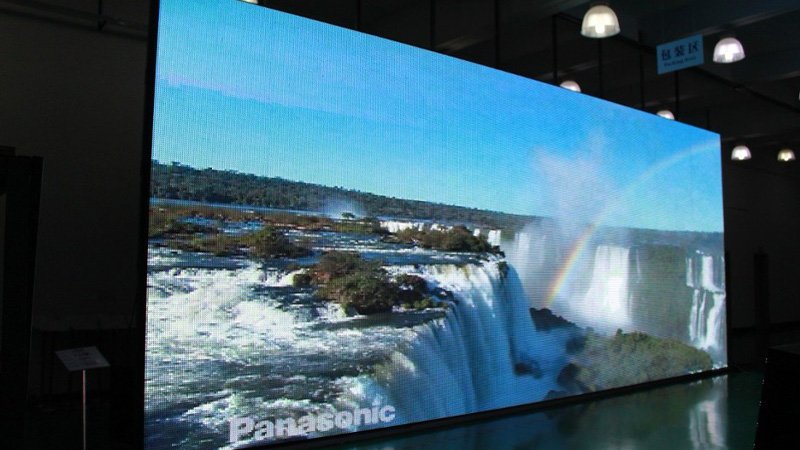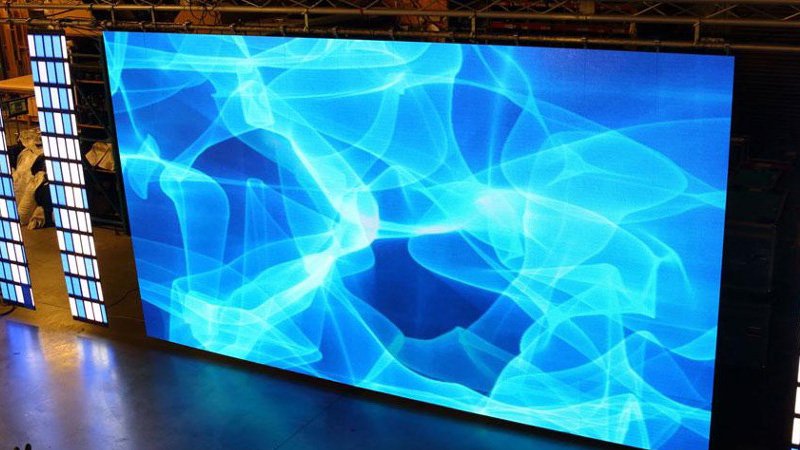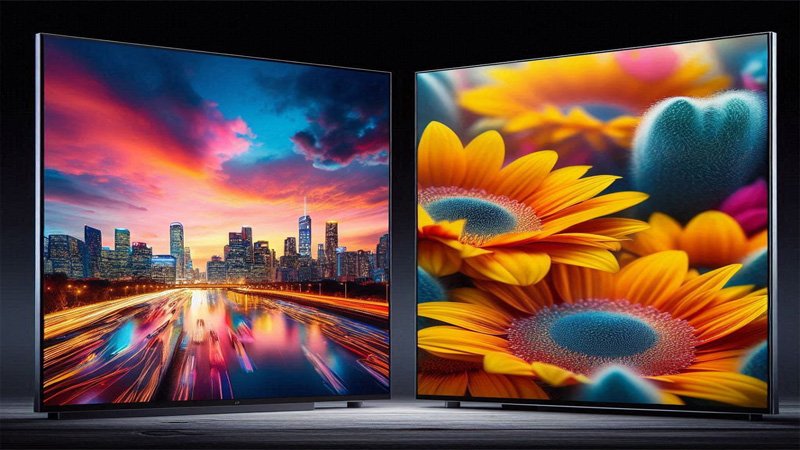The choice between LCD and LED screens has become a critical decision for consumers seeking optimal visual experiences. In the digital age, the demand for high-quality displays in various devices, from televisions to computer monitors and smartphones, has surged. This is why it is important to understand the differences between LCD and LED screens for making informed choices when selecting electronic devices.
This article discusses the differences between LCD and LED technologies, exploring their respective features, advantages, and limitations. We will also discuss some of the important factors to consider when comparing LCD and LED screens. But before we get into the differences, let’s understand how LED screens work so we can compare these screen types with the LCD screens.
1. How LED Screens Work?
LED (Light Emitting Diode) lies at the core of a revolutionary display technology that has reshaped how displays work. Unlike traditional LCD display screens, where a backlight is required to illuminate pixels, LED screens boast a self-illuminating capability, contributing to enhanced contrast ratios and energy efficiency.
Light-Emitting Diodes
LED screens are mainly run by tiny semiconductor devices known as light-emitting diodes. These diodes emit light when an electric current passes through them, producing a vibrant and dynamic display. Each LED functions as an individual pixel, collectively forming the intricate mosaic of colors and images that grace the screen.
Direct Illumination and Improved Contrast
One of the key advantages of LED screens is their ability to provide direct illumination. Unlike LCDs, which rely on a separate backlight that may result in uneven brightness and limited control over contrast, LEDs have their own light. This feature contributes to deeper blacks and more vibrant colors, producing a visually striking and immersive experience.
Types of LED Displays: Edge-Lit vs. Full Array
LED screens come in different configurations, primarily categorized as edge-lit and full-array. Edge-lit LEDs position the diodes along the edges of the display, allowing for a sleek and slim design. On the other hand, full-array LEDs are distributed uniformly across the entire back panel, affording greater control over localized dimming and enhancing overall picture quality.
Color Accuracy and Energy Efficiency
LED screens excel in rendering accurate and vivid colors, owing to their precise control over individual diodes. This capability not only enhances the viewing experience but also makes LED display screens and panels popular choices for professional applications such as graphic design and video editing. Also, LEDs are inherently energy-efficient, as they can be dimmed or turned off entirely in areas displaying black or dark content, leading to energy savings and environmental benefits.
Understanding how LED screens work provides valuable insights into their advantages over traditional LCD technology. Now let’s explore further inside the characteristics of LED screen panels, which will facilitate a comprehensive comparison between these two prevalent technologies.

2. Inside LED Screen Panels
Delving deeper into the world of LED screens involves unraveling the anatomy of their intricate panels, where cutting-edge technology converges to deliver captivating visual experiences.
Pixel Pitch and Resolution
Central to the clarity and detail of an LED screen is the concept of pixel pitch. Pixel pitch refers to the distance between individual pixels, influencing the screen’s resolution. LED screens with smaller pixel pitches tend to offer higher resolutions and sharper images, making them particularly suitable for applications where precision and clarity are paramount.
Color Composition and LED Types
LED screens employ a combination of red, green, and blue (RGB) LEDs to generate a broad spectrum of colors. The quality and range of colors are influenced by the type of LEDs used. For instance, modern LED screens often utilize organic light-emitting diodes (OLED) or quantum dot technology, pushing the boundaries of color reproduction and vibrancy.
Refresh Rates and Smooth Motion
A critical factor in delivering smooth and seamless visuals is the refresh rate of an LED screen. Measured in Hertz (Hz), the refresh rate determines how many times per second the screen updates the image. Higher refresh rates contribute to smoother motion, reducing motion blur and enhancing the overall viewing experience, especially in fast-paced content such as gaming or action-packed videos.
Brightness and Contrast
The luminosity of an LED screen is a vital parameter that significantly influences visibility and image quality. Measured in nits, brightness levels vary across different LED displays. Additionally, the ability to achieve deep blacks and high contrast ratios is a hallmark of LED technology, adding depth and realism to images.
Durability and Longevity
LED screens are renowned for their durability and longevity. The absence of moving parts, as seen in traditional displays like cathode-ray tubes (CRT), contributes to their robust design. LEDs also have a longer lifespan compared to traditional light sources, ensuring prolonged and reliable performance.
Understanding the mechanism of LED screen panels empowers consumers to make informed decisions based on their specific preferences and usage scenarios. Now that you have a deep understanding of how LED displays work, let’s look at some of the features and benefits of LED display screens.

3. Features and Benefits of LED Display Screen
Embracing LED display screens brings forth a myriad of features and benefits that cater to the ever-evolving demands of modern consumers. From vibrant visuals to energy efficiency, LED technology offers a compelling array of advantages that set it apart in display innovation.
Vivid and Accurate Colors
LED display screens excel in reproducing vibrant and accurate colors, thanks to their precise control over individual diodes. The RGB (Red, Green, Blue) LEDs combine seamlessly to create a broad spectrum of colors, delivering stunning visuals with unmatched clarity. This feature is particularly beneficial for applications demanding color accuracy, such as graphic design and video editing.
High Contrast Ratios and Deep Blacks
The self-illuminating nature of LED screens allows for unparalleled control over contrast ratios. This results in deep blacks and bright whites, enhancing the overall visual experience. Whether watching a movie, playing a game, or working on detailed graphics, the high contrast ratio contributes to sharper and more immersive content.
Energy Efficiency and Environmental Friendliness
LED screens are inherently energy-efficient, contributing to lower power consumption compared to traditional display technologies. The ability to selectively dim or turn off individual diodes in areas displaying dark content leads to energy savings. This not only benefits consumers in terms of reduced utility costs but also aligns with environmentally conscious practices.
Slim and Sleek Design
The design flexibility of LED technology allows for slim and sleek screen profiles. Whether in televisions, monitors, or digital signage, LED screens provide a contemporary aesthetic without compromising on performance. Edge-lit and full-array configurations contribute to the versatility of designs, meeting the aesthetic preferences of a wide range of consumers.
Longevity and Durability
LED display screens boast a longer lifespan compared to traditional display technologies. The absence of moving parts, coupled with the robust nature of semiconductor diodes, contributes to the durability and reliability of LED screens. This longevity ensures a prolonged and consistent performance, reducing the need for frequent replacements.
Wide Viewing Angles
LED screens typically offer wide viewing angles, allowing viewers to enjoy consistent and accurate colors from various perspectives. This feature is particularly advantageous in scenarios where multiple individuals gather around a screen, such as in home entertainment setups or collaborative work environments.
Adaptability to Various Applications
The versatility of LED display screens extends to their adaptability across a wide range of applications. From home entertainment systems and gaming setups to professional displays and outdoor signage, LED technology proves itself as a dynamic solution capable of meeting diverse requirements.
Understanding the features and benefits of LED display screens provides a comprehensive perspective for consumers navigating the market.

4. The Differences Between LED vs. LCD Screens
While both technologies contribute to the vibrant array of screens available in the market, understanding their fundamental differences is crucial for making informed decisions tailored to individual preferences.
Now that you have a brief understanding of how LED screens work in comparison with LCD screens, let’s delve deeper into the major differences between both the LED and LCD screens.
Backlighting Technology
LED Screens: LEDs serve as both the light source and pixel in LED screens. Each pixel is a tiny light-emitting diode, allowing for self-illumination and precise control over brightness.
LCD Screens: LCDs, on the other hand, require a separate backlight to illuminate the pixels. This backlight can be made using various technologies, such as cold cathode fluorescent lamps (CCFLs) in older LCDs or LEDs in more modern iterations.
Contrast and Black Levels
LED Screens: LED screens generally offer higher contrast ratios and deeper blacks due to their ability to individually control each diode’s brightness. This contributes to more vibrant and lifelike visuals.
LCD Screens: While LCDs have made advancements in contrast ratios, they may struggle to achieve the same level of deep blacks as LEDs due to the presence of a backlight that may lead to light leakage.
Slim Design
LED Screens: The design flexibility of LED display technology allows for slim and sleek screen profiles. LEDs can be arranged along the edges (edge-lit) or uniformly across the entire back panel (full-array), enabling aesthetically pleasing and space-saving designs.
LCD Screens: LCDs, especially older models with CCFL backlighting, may be bulkier due to the nature of the backlight technology.
Energy Efficiency
LED Screens: LED screens are inherently energy efficient. Their ability to selectively dim or turn off individual diodes in darker areas of the screen results in lower power consumption.
LCD Screens: LCD display screens, particularly those with CCFL backlighting, may consume more power since the backlight is consistently on.
Viewing Angles
LED Screens: LED screens generally provide wide viewing angles, ensuring consistent and accurate colors from various perspectives.
LCD Screens: Older LCDs, especially, may exhibit color shifts and reduced visibility at wider angles.
Environmental Impact
LED Screens: The energy efficiency of LED screens contributes to reduced environmental impact, aligning with eco-friendly practices.
LCD Screens: LCDs may have a comparatively higher environmental footprint, especially if they use energy-intensive backlighting technologies.
As we navigate the realm of display technologies, the dissimilarities between LED and LCD screens serve as guideposts for consumers seeking displays that align with their specific preferences, use cases, and environmental considerations. The choice ultimately boils down to a nuanced understanding of these differences and the unique advantages each technology brings to the visual landscape.

5. Helpful Tips for Choosing the Right LED Screen
Selecting the perfect LED screen can be a daunting task given the multitude of options available in the market. Whether you are in search of a television, monitor, or digital signage, considering a few key factors will help you make an informed decision that aligns with your preferences and requirements. Here are some helpful tips to choose the right LED screen.
Define Your Purpose
Identify the primary purpose you will be using the LED screen for. Whether it’s for gaming, professional graphic design, home entertainment, or business presentations, understanding your specific use cases will guide you toward the features that matter most.
Understand Resolution Requirements
Higher-resolution screens with smaller pixel pitches offer greater detail. Assess your need for clarity and detail in images and videos to determine the appropriate resolution for your chosen screen size.
Evaluate Screen Size
The ideal screen size depends on the viewing distance. For larger spaces or if you sit farther away, a larger screen may be necessary for an immersive experience. Conversely, for smaller spaces or closer viewing, a smaller screen may suffice.
Review Refresh Rates for Motion
If you plan to use LED screens for gaming or watching fast-paced videos, consider a higher refresh rate (measured in Hertz) for smoother motion and reduced motion blur.
Assess Contrast Ratios
Evaluate the contrast ratios offered by different LED screen types. Higher contrast ratios contribute to deeper blacks and enhanced visual quality, especially in dimly lit environments.
Consider Connectivity Options
Ensure the LED screen has the necessary input ports for your devices, whether it’s HDMI for gaming consoles, DisplayPort for computers, or USB for multimedia playback. Future-proofing your purchase with versatile connectivity options is beneficial.
Explore Smart Features
If you’re opting for a television or monitor, consider smart features such as built-in streaming apps, voice control, and compatibility with smart home devices for added convenience.
By keeping these tips in mind, you can navigate the vast array of LED screens with greater confidence, ensuring that your chosen display aligns seamlessly with your preferences and enhances your visual experiences.

6. Conclusion
The decision of choosing LCD or LED screen panels depends on your personal preferences and specific needs. LED screens stand out for vibrant colors, high contrast, and energy efficiency, making them versatile across various applications. On the other hand, LCD screens continue to evolve, offering improved visuals and competitive features.
Your ideal choice depends on what matters most to you – whether it’s the sleek designs and energy efficiency of LEDs or the evolving capabilities of LCDs. As technology advances, innovations like OLED and quantum dot technologies add more layers to the decision-making process. Ultimately, understanding your priorities will guide you toward a display that seamlessly complements your lifestyle and enhances your visual experience.
If you are seeking a perfect LED screen for your specific needs, head towards LEDSINO store to find the screen that fits your needs. We have a wide range of options available – explore the available LED screens and panels for sale and enhance your display experience!



